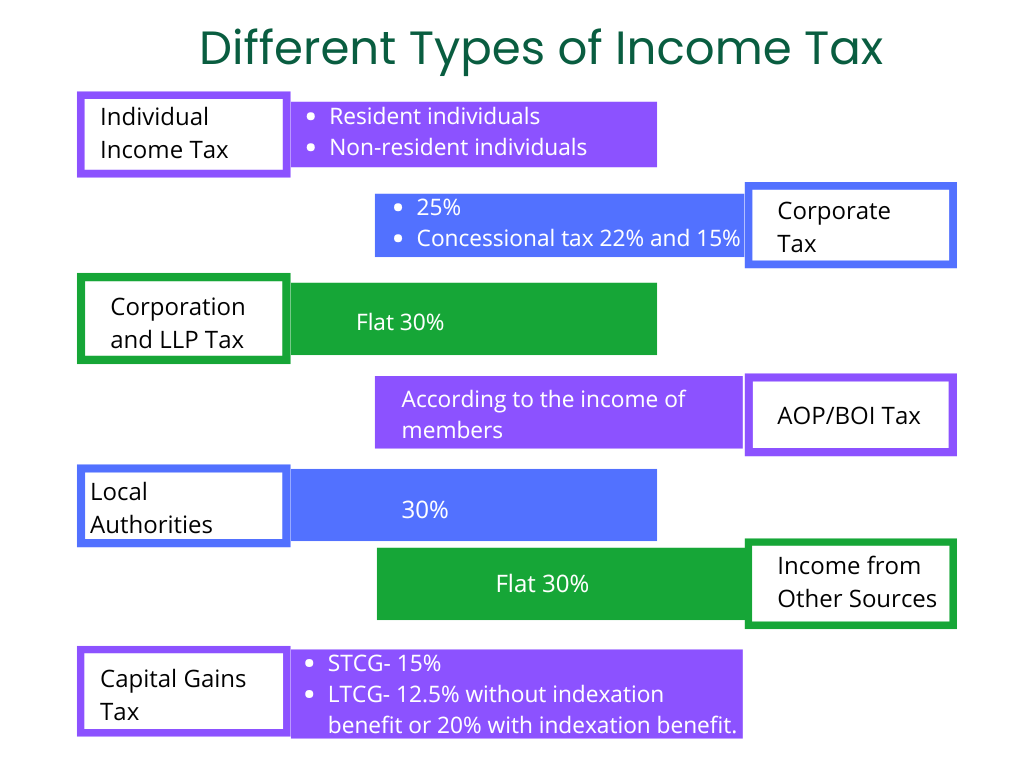What are the different types of income taxes?
It is an income tax that the Indian government levies on the income that a person is earning in India, individually or in a group, be it a business. It is one of the largest fundamental channels by which the public services, facilities, and welfare measures in such a country are financed and, therefore, is a very vital financial source for supporting growth. Indian taxation system offered under the law known as the Income Tax Act of 1961 that is implemented under the Central Board of Direct Taxes (CBDT). India income tax is charged according to the classification of the kind of taxpayer and kind of income. This article discusses various types of income taxes in India.

Individual Income Tax
For a person, it is levied on the total income of a person for a financial year. For purposes of taxation, people are classified into categories:
- Resident Individuals: This refers to the persons who fulfill such specific residency requirements under the Income Tax Act and are taxed on income earned anywhere across the globe, including outside of India.
- Non-Resident Individuals (NRI): Income earned or accrued is taxed if an NR comes from India.
Individual taxpayers are further classified by age and level of income:
- Ordinary Individuals (below 60 years of age)
- Senior Citizens (60–80 years old)
- Super Senior Citizens over 80 years of age.
Taxes on Hindu Undivided Families (HUFs)
HUF is separately taxed, presumably. HUF means Hindu Undivided Families. It is an arrangement under Hindu law, and it’s constituted of members who are descended from a common ancestor.
- This head of income covers all earnings received from the HUF through ancestral property, business, or other sources.
- HUFs enjoy identical deductions and exemptions available to individuals, including Section 80C deductions.
Corporate Tax
It is charged on registered Indian companies under the Companies Act of India and foreign companies operating in the country. The corporation tax rate varies for different categories:
- Domestic companies are liable to pay tax on global incomes. The rate is on the basis of turnover and other parameters. For companies whose turnover has not exceeded ₹400 crore, it is 25 percent. Except that companies falling under Section 115BAA or Section 115BAB who have exercised their option for concessional tax regime are taxed at 22% or 15%, respectively.
- Foreign Companies: Taxed only on the income earned or accrued in India. Tax rate: slightly more than domestic companies. May vary based on bilateral tax treaties.
Tax on Corporation and LLP
An extremely important fact is that the Income Tax Act has incorporated partnership firms, as well as limited liability partnerships (LLPs), within it. The major features are enumerated below:
- 30% of flat tax on their aggregate income.
- No slab rate advances apply to individuals.
- Companies and LLPs have been permitted to set off expenses from the operation.
Income Tax of Bodies of Individual-Association of Persons (BOI-AOP)
AOP and BOI stand for Associations of Persons and Bodies of Individuals, respectively, that are assemblies of persons or other entities joining together to achieve a common goal.
- AOPs and BOIs are treated as separate legal entities for tax purposes if the income is not distributed among its members.
- If the income goes to the hands of members, then it is taxed in their hands at the member’s slab rates.
Tax on Local Authorities
Local authority income other than from core sources is considered taxable. Such sources are either municipal bodies or panchayats. Examples include:
- Income from rent, fees, or investments is taxable.
- Taxes Local authorities usually demand a 30% tax rate.
Trust and Charitable Institution Tax
Charitable trusts and institutions are taxed according to their activities.
- Charitable or religious trusts can be exempted under Section 11 and Section 12 of the Income Tax Act, if granted certain conditions.
- All earnings from non-charitable activities are taxable.
Capital Gains Tax
It is a tax on income earned from capital assets such as real estate, stocks, or bonds. There are two kinds of capital gains tax:
- Short-term capital gains (STCG). Used when holding assets for less than 36 months. Taxation rates depend on the asset, for example, equities – 15%.
- Long-Term Capital Gains: This is on assets held for more than 36 months. The applied tax rate usually tends to be smaller, like 10% or 20% with the benefits of indexation.
Tax on Income from Other Sources
Income from sources not covered under any of the foregoing heads, such as winnings from lotteries, gambling, or interest on fixed deposits, fall in this category.
- This source of income earns income taxes at a flat rate, usually higher than the prevailing rates. Examples include lottery winnings paid tax at a flat rate of 30%.
Minimum Alternate Tax (MAT)
MAT is levied on companies that, despite heavy profits generation, pay little or no tax due to exemptions and deductions.
- MAT provisions mandate domestic and foreign companies to pay an excise tax amounting to at least 15% on their book profits.
- Exemptions under MAT for startups and companies set up in special economic zones (SEZs) subject to certain conditions.
Dividend Distribution Tax (DDT)
Earlier, Dividend Distribution Tax was required to be paid by the distribution companies. This tax was, however, repealed in 2020. Dividend Tax is now payable in the hands of shareholders at their respective applicable slab rates. discussed above are the various types of income taxes in India.
Conclusion
India’s income tax structure is complex as it deals with a wide array of taxpayers by type and source. It shall encompass both progressive and equitable principles so that taxpayers actually share funds for nation-building proportionate to one’s earning capacity. Being aware of which kind of tax applies, at what rate, and under what conditions of deduction will help the individual and/or business make better planning and be within tax law requirements.

